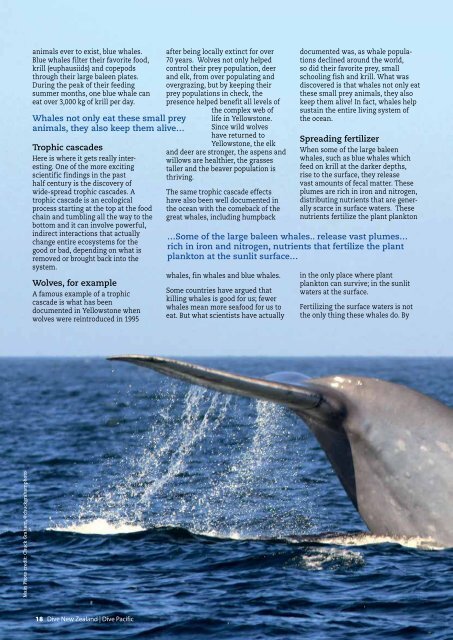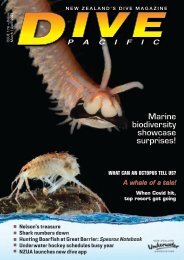Dive Pacific 175 Dec2020 Jan 2021
Dive Pacific, New Zealand's Dive Magazine , captures the best of diving in New Zealand and the Pacific. with adventures, top photos and expert technical advice
Dive Pacific, New Zealand's Dive Magazine , captures the best of diving in New Zealand and the Pacific. with adventures, top photos and expert technical advice
Create successful ePaper yourself
Turn your PDF publications into a flip-book with our unique Google optimized e-Paper software.
animals ever to exist, blue whales.<br />
Blue whales filter their favorite food,<br />
krill (euphausiids) and copepods<br />
through their large baleen plates.<br />
During the peak of their feeding<br />
summer months, one blue whale can<br />
eat over 3,000 kg of krill per day.<br />
Whales not only eat these small prey<br />
animals, they also keep them alive…<br />
Trophic cascades<br />
Here is where it gets really interesting.<br />
One of the more exciting<br />
scientific findings in the past<br />
half century is the discovery of<br />
wide-spread trophic cascades. A<br />
trophic cascade is an ecological<br />
process starting at the top at the food<br />
chain and tumbling all the way to the<br />
bottom and it can involve powerful,<br />
indirect interactions that actually<br />
change entire ecosystems for the<br />
good or bad, depending on what is<br />
removed or brought back into the<br />
system.<br />
Wolves, for example<br />
A famous example of a trophic<br />
cascade is what has been<br />
documented in Yellowstone when<br />
wolves were reintroduced in 1995<br />
after being locally extinct for over<br />
70 years. Wolves not only helped<br />
control their prey population, deer<br />
and elk, from over populating and<br />
overgrazing, but by keeping their<br />
prey populations in check, the<br />
presence helped benefit all levels of<br />
the complex web of<br />
life in Yellowstone.<br />
Since wild wolves<br />
have returned to<br />
Yellowstone, the elk<br />
and deer are stronger, the aspens and<br />
willows are healthier, the grasses<br />
taller and the beaver population is<br />
thriving.<br />
The same trophic cascade effects<br />
have also been well documented in<br />
the ocean with the comeback of the<br />
great whales, including humpback<br />
…Some of the large baleen whales.. release vast plumes…<br />
rich in iron and nitrogen, nutrients that fertilize the plant<br />
plankton at the sunlit surface…<br />
whales, fin whales and blue whales.<br />
Some countries have argued that<br />
killing whales is good for us; fewer<br />
whales mean more seafood for us to<br />
eat. But what scientists have actually<br />
documented was, as whale populations<br />
declined around the world,<br />
so did their favorite prey, small<br />
schooling fish and krill. What was<br />
discovered is that whales not only eat<br />
these small prey animals, they also<br />
keep them alive! In fact, whales help<br />
sustain the entire living system of<br />
the ocean.<br />
Spreading fertilizer<br />
When some of the large baleen<br />
whales, such as blue whales which<br />
feed on krill at the darker depths,<br />
rise to the surface, they release<br />
vast amounts of fecal matter. These<br />
plumes are rich in iron and nitrogen,<br />
distributing nutrients that are generally<br />
scarce in surface waters. These<br />
nutrients fertilize the plant plankton<br />
in the only place where plant<br />
plankton can survive; in the sunlit<br />
waters at the surface.<br />
Fertilizing the surface waters is not<br />
the only thing these whales do. By<br />
Main Photo credit: Chuck Graham, @chuckgrahamphoto<br />
18 <strong>Dive</strong> New Zealand | <strong>Dive</strong> <strong>Pacific</strong>













